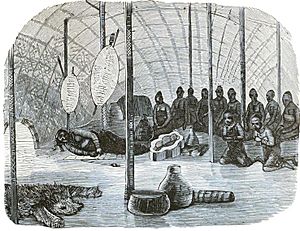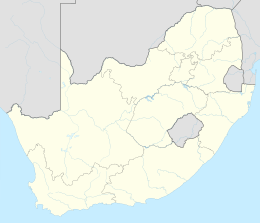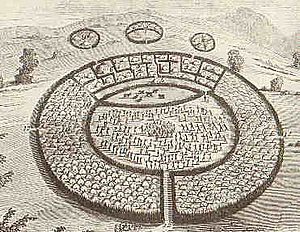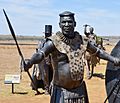Dingane facts for kids
Quick facts for kids Dingane |
|
|---|---|
| King of the Zulu Kingdom | |
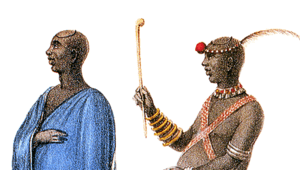
Dingane in ordinary and dancing dress
|
|
| Reign | 1828–1840 |
| Coronation | 1828 |
| Predecessor | Shaka |
| Successor | Mpande |
| Born | 1795 |
| Died | 1840 (aged 44–45) Hlatikhulu Forest, current KwaZulu-Natal |
| Spouse | unknown |
| Issue | unknown |
| House | Zulu royal family |
| Father | Senzangakhona kaJama |
| Mother | Mpikase kaMlilela Ngobese |
Dingane ka Senzangakhona Zulu (around 1795–29 January 1840) was a Zulu prince. He became king of the Zulu Kingdom in 1828. He took over after his half-brother Shaka Zulu died.
Dingane built his royal capital, uMgungundlovu, in the eMakhosini Valley. This area was south of the White Umfolozi River, on the side of Lion Hill.
Contents
Becoming King
Dingane became king in 1828. He took power after his half-brother Shaka died. He was helped by another brother, Umhlangana, and Shaka's bodyguard, Mbopa.
People said they killed Shaka because he became very harsh. This happened after his mother, Nandi, passed away. The event took place in what is now Stanger.
How Dingane Ruled
People saw Dingane as a very important leader. Captain Allen Gardiner said he was like a "great idol" to the Zulu nation. A missionary named Rev. Francis Owen watched Dingane's rule closely. Owen noted that Dingane had a very strong way of governing.
Dingane's people believed he was almost like a god. They thought he had always been king and would never die. When asked when his rule began, they would say "hundreds and hundreds of years ago." During meals, they would raise their hands and shout, "You are greater than the heavens!"
Dingane's helpers, female attendants, and servants did not act or speak without his command. Owen noticed that even Dingane's main advisor, Ndlela kaSompisi, would not visit him unless the king ordered it. No one would help Owen with simple tasks unless Dingane allowed it.
Dingane had many female attendants, about 500 of them. He called them his sisters or children. They were organized into different groups. They could only leave the royal area if he gave permission. When they did leave, they were not allowed to look at any men or boys. Owen saw them outside the palace a few times, like when they sang or brought thatch for his hut.
Dingane let Owen live near his capital. However, Dingane thought the Christian faith was just a story from the English. He believed it was not useful for him or his people. One Sunday, he allowed Owen to explain Christianity to nearly 1,000 Zulu men. They sat in a semi-circle, drinking beer. Dingane seemed annoyed by the message. He said it was old news and did not fit their beliefs. He stated, "I and my people believe there is only one God – I am that God. ... I am the Great Chief – the God of the living."
The Royal Home at UmGungundlovu
Dingane built his capital city, umGungundlovu, in 1829. He made it bigger five years later. UmGungundlovu was built like a typical Zulu military camp, called an ikhanda.
The ikhanda had a large, round parade ground in the middle. This was called the isibaya esikhulu. Around it were huts for warriors and storage for their shields. The main entrance to the isibaya was from the north.
The king's private area, called the isigodlo, was on the south side. It was directly across from the main entrance. The king, his female attendants, and mistresses lived here. There were at least 500 people in this area.
The women were split into two groups: the black isigodlo and the white isigodlo. The black isigodlo had about 100 special women. Within this group, a smaller number of girls, called the bheje, were favored by the king. A small village was built for them behind the main area for some privacy. The rest of the king's women were the white isigodlo. These were mostly girls given to the king by important people. He also chose other girls at the yearly first fruit ceremony.
A large, half-moon shaped area was part of the black isigodlo. Here, the women and the king would sing and dance. The huts in the black isigodlo were divided into sections of about three huts each. These sections were surrounded by a two-meter-high hedge, creating many paths.
The king's personal hut, called an ilawu, was in one of these sections. It had three or four entrances. His hut was very big and kept very clean by attendants. It could easily hold 50 people. Digging by archaeologists has shown that this hut's floor was about 10 meters wide. They found signs of 22 large support posts inside the hut. These posts were covered in glass beads. Visitors like Piet Retief and missionaries George Champion and Francis Owen had written about these beads.
On the south side, behind the main complex, were three separate groups of huts. The middle group was used by the uBheje women. In this area, they prepared chosen young girls to serve the king.
Challenges to Dingane's Rule
Dingane was not as skilled a military leader as Shaka. Some chiefs rebelled and left his rule. Chiefs who lost Dingane's favor also fled the country, like Signabani.
People who could not escape with Signabani were gathered and killed. These problems became worse due to fighting with the new settlers, called Voortrekkers.
Fighting the Voortrekkers
In November 1837, Dingane met with Piet Retief, a leader of the Voortrekkers. Dingane agreed to give them land if they helped him get back some stolen cattle. He signed a document about this land. It is believed Dingane knew what he was signing. However, he likely did not fully understand the idea of owning land forever. This was not a Zulu custom.
On February 6, 1838, after two days of celebrations, Dingane had Retief and his group killed. They had been told to leave their guns outside the royal area. Suddenly, during a dance, Dingane shouted, "Kill the wizards!"
Retief and his men were overpowered and taken to a hill called kwaMatiwane. They were killed there. Some people say they were killed because they did not return all the cattle they had recovered. Most people believe Dingane did not want to give up the land he had promised. He also did not trust the Voortrekkers.
At the same time, Dingane's forces attacked Retief's group of settlers. About 500 Voortrekkers and their servants, including women and children, were killed. The Voortrekkers called this event the Weenen massacre. The nearby town of Weenen (which means "weeping" in Dutch) was named in memory of this sad event.
Dingane then ordered his army to find and kill the Voortrekker group led by Andries Pretorius. The Zulu army attacked their camp. But they were defeated in the Battle of Blood River. About 3,000 Zulus were killed. Dingane's commander in this battle was Ndlela kaSompisi.
Overthrow and Death
In January 1840, Pretorius and 400 Voortrekkers helped Mpande. Mpande was Dingane's half-brother. He was rebelling against Dingane. This led to Dingane being overthrown and killed. Mpande then became the new king.
At the Battle of Maqongqo, many of Dingane's own soldiers left him and joined Mpande's army. Dingane had his general, Ndlela kaSompisi, killed. With a few followers, Dingane escaped to the Lubombo mountains. A group of Nyawo and Swazi people killed him in Hlatikhulu Forest.
Dingane's grave is near Ingwavuma in the Hlatikulu Forest. It is about an hour's drive from Tembe elephant park.
| King of the Zulu Nation | ||
| Preceded by: Shaka |
Reign 1828–1840 |
Succeeded by: Mpande |
Images for kids
-
Bronze statue of Dingane at Maropeng, in the Long March to Freedom exhibition
See also
 In Spanish: Dingane kaSenzangakhona para niños
In Spanish: Dingane kaSenzangakhona para niños


